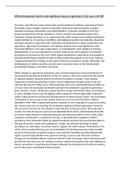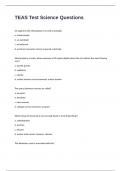Which development had the most significant impact on agriculture in the years 1625-88?
The years 1625-88 were some of the most transformational in Britain’s agricultural history.
Essentially, these changes came from incentive. With more industrial goods available
through increasing urbanisation and industrialisation, it became valuable to farm for a
greater purpose than merely subsistence. Hence, farmers who adapted quicker were
rewarded. Seeing agriculture as an opportunity for profit, bankers and wealthy landowners
quickly latched on, increasing competition and making innovation and adaption absolutely
necessary aspects of agricultural life. Ultimately, developments in capital investment into
agriculture, agricultural techniques, and national markets were most significant in the
increasing efficiency and scale of agriculture. In evaluating the most significant of these
developments, it is most important to consider which of the three allowed or prompted
production to increase by the most. While capital investment in agriculture and changes in
agricultural technique primarily worked to allow productive capacity to increase, national
markets prompted this change, as they gave incentive to produce a surplus. Ultimately, the
development of national markets was the more important factor as this development
precipitated changes in the other two areas.
While changes in agricultural techniques were certainly important as the embodiment of
the growth of agricultural production in the 17th century, they were inspired by the growth
of national markets, giving incentives to farmers to produce a surplus. Crop rotation,
frequently involving the planting of clover, which replenished nitrogen levels in the soil,
reduced the need for fallow years. With previously one in four fields dedicated as fallow on
a 4-year cycle, this innovation drastically increased the productive capacity of agricultural
land. However, clover’s limited use meant that this change had limited effect on production
of more valuable cereal crops. By digging water meadows, farmers kept fields constantly
damp, reducing the risk of frost and allowing horses to feed on grass earlier. This innovation
contributed to an increase in the number of horses on farms from 300,000 in 1600 to
630,000 in 1700. With a significantly greater capacity to carry a plough for long period of the
day, horses were key to unlocking the productive capacity of British agriculture. However,
this increase in horses was not simply to make the lives of farmers easier, but to produce a
surplus, to trade for luxuries such as more desirable Dutch cloths, which became desirable
across the nation thanks to improved transport and national markets. Hence, while water
meadows contributed to a significant increase in the productive capability of British
agriculture, they frequently relied on capital investment and this risk was only desirable for
the goal of luxuries, rather than subsistence. Finally, the selective breeding of sheep
developed as a technique to produce wool to support the cloth industry. Particularly in the
north, where pastoral farming was more profitable, this development was made possible
purely by the growth of national markets. Since selective breeding naturally followed the
region’s general specialisation into pastoral farming, it can be seen that none of these
changes are sustainable without assurance that this cash-crop-esque style of farming would
provide the food necessary for families to survive without farming for their own subsistence.
Hence, innovations in agricultural technique followed the development of national markets,
even if they were contributed to their growth.





